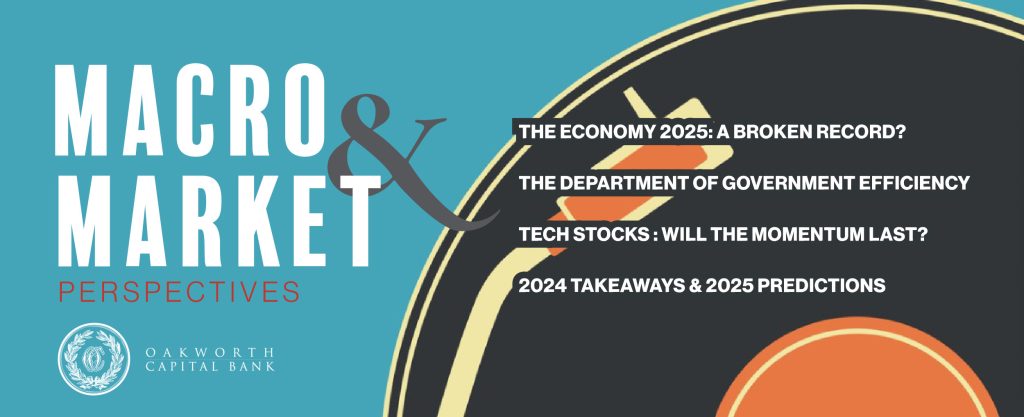Simply put, it has been a hard year to complain about. Of course, some investors can always find a reason–but that’s nothing new.
THE STOCK MARKET
This year marked a notable and positive shift in the global investment landscape, despite doom and gloom from a whole host of sources. While economic uncertainty, continued inflationary pressures and fluctuating interest rates persisted, investors were greeted with a relatively stable market environment in 2024. This allowed equities to shine, as corporate earnings, economic growth and investor sentiment all aligned to provide a favorable backdrop for stocks to largely move up and to the right. It’s a familiar story: U.S. equities continued to lead the way, driven largely by large-cap tech stocks. But there was a differentiator from 2023, too: the market’s strength broadened out beyond large-cap tech stocks, with more names and sectors contributing to the stellar year.
FIXED INCOME
On the flip side, the fixed-income market had a far less exciting 2024. Despite sharply rising bonds in previous years offering silver linings for some investors, 2024 failed to deliver the same level of excitement. With interest rates remaining relatively high and inflation slowing only gradually, fixed-income securities—particularly long-duration bonds—suffered. Investors holding bonds with any sort of duration faced flat or modestly negative returns as the interest rate environment continued to weigh heavily on bond prices. The bond market’s lackluster performance was compounded by the uncertainty over central bank actions, creating an environment where the excitement in the equity market did not translate over to the bond market.
Ultimately, 2024 served as a reminder of the dynamic nature of financial markets, reinforcing the adage that “the majority of returns are driven by asset allocation.”
Though a welcome development for investors, the strong rally in equities throughout 2024 may set the stage for a tougher outlook this year. With stocks reaching new highs and valuations climbing to lofty levels, the market faces an increasingly challenging environment for sustaining the momentum.
HOW CAN STOCKS KEEP THIS UP?
This very question leaves little room for error as investors turn their attention to 2025. As discussed in previous quarterly pieces, earnings matter, especially over the long run. Earnings multiples can expand and contract over the short run but sustained long-term growth and compounding rely on earnings growth. This sets the stage for higher earnings expectations priced in for the coming year. Achieving returns similar to this year’s success will require delivering on those expectations. That doesn’t mean it’s not possible, just a higher bar.
OAKWORTH’S EQUITY ALLOCATION
So, what does this mean for our overall equity allocation? Given the current backdrop, we continue to want to overweight equities, specifically domestic equities. In our prediction piece, we continue to forecast the likelihood of the U.S. markets continuing to outperform. While things may be rocky here at times, international investing is largely a relative game. And when comparing our outlook to the rest of the world things look pretty good. Inflation is mostly under control, and our economy continues to grow. The same cannot be said for the rest of the developed world, emerging markets or the once-favored China.
Within our domestic equities, allocating more to small-cap, mid-cap and value stocks —all with more attractive valuations—helps to “lower the bar” for the earnings growth we need to expect. And to add to it, any additional rate cuts we see in 2025 should help to lift these areas of the market.
BROADENING OUT
This is what we mean by positioning ourselves for a broadening out, which we have already started to experience this year. It is no longer just the mega-cap tech names that are contributing to the markets returns. While most of those are still doing great, we have begun to see more names and sectors doing well. These include financials, industrials, and even some staples. More names contributing to the overall returns is a sign of a pretty healthy market.
While equities have lofty expectations, the playbook for solid returns is pretty clear. However, for fixed income, the roadblocks that are in place make that playbook for a strong year far less certain. One of the main challenges is the uncertain outlook for Federal Reserve policy. After aggressive rate hikes in 2022 and 2023 and sharp cuts in late 2024, the market appears set for a pause from the Fed. Though inflation has improved, core inflation remains above the Fed’s 2% target and the labor market isn’t budging much. This has made the Fed’s job a little more difficult. With their dual mandate of maximum employment and price stability not fully achieved due to lingering inflation, it has forced them to walk a tight rope of slowing things down enough to rein in inflation… but not slowing too much to significantly impact the labor market. I would not want that job.
For bondholders, this means that the interest rate environment may stay restrictive for longer, keeping bond prices lower, especially for long-duration bonds, creating an environment with downside risk and uncertainty. Not a great combination.
GOVERNMENT DEBT
Adding to the Fed’s challenges is the U.S. government’s large (and growing) budget deficit, which will continue to drive up our growing debt. The government’s spending on defense, social programs, and other expenditures, coupled with the rising costs of servicing the national debt, ensure Treasury issuance will remain high, with close to $2 trillion in new debt expected next year. Increased Treasury issuance will boost bond market supply, putting downward pressure on bond prices if demand from foreign investors doesn’t keep pace.
What has this translated to for our fixed income allocation? Simply put we want to be underweight, and we do not want to extend our duration. Accomplishing these has helped insulate the bond portion of client portfolios from the impact of rising longer-term interest rates.
CAUTIOUS OPTIMISM
The year 2025 seems to have a lot of uncertainty for the markets. Maybe that is true, or maybe that is just the natural feeling that comes with entering a new year, especially after such a good 2024. Who knows. Nonetheless, we continue to remain cautiously optimistic about what the next year will hold. Not a repeat of 2024, but all-in-all we still expect economic growth and corresponding earnings growth. That alone should be enough to generate a decent return for the following year, given the cards we are currently playing with. A broadening out has begun, and we think that’s a trend that should continue. As a result, we continue to position our portfolios to capture this opportunity with a broad portfolio, overweighting a wide range of domestic equities while underweighting fixed income and cash.
While we have a sense of confidence in our predictions, one prediction that I know will come true, is that things will change, and new highs and lows will appear next year. With that being said, we will continue to remain flexible and opportunistic, looking for opportunities to capitalize on whatever may arise.
This content is part of our quarterly outlook and overview. For more of our view on this quarter’s economic overview, inflation, bonds, equities and allocations, read the latest issue of Macro & Market Perspectives.

The opinions expressed within this report are those of the Investment Committee as of the date published. They are subject to change without notice, and do not necessarily reflect the views of Oakworth Capital Bank, its directors, shareholders or associates.


